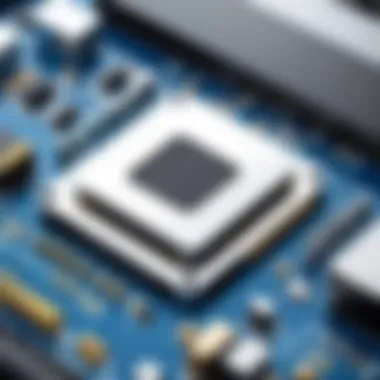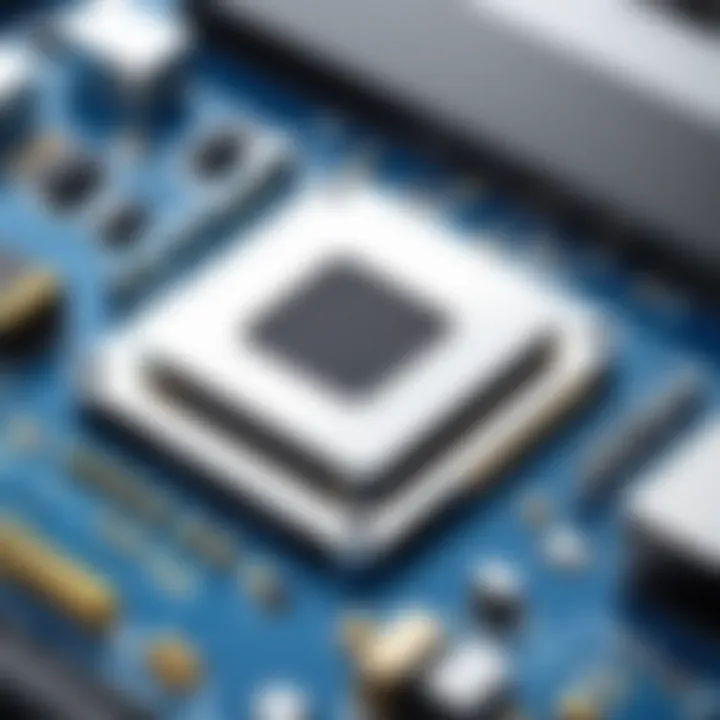Diagnosing and Resolving Windows 10 Performance Issues


Intro
Windows 10 is a robust operating system that caters to a diverse range of users and applications. However, like any complex system, it can experience performance issues that frustrate users and hinder productivity. Slow response times, application crashes, and sluggish performance contribute to an underwhelming experience. Understanding the underlying causes of these issues is crucial for effective resolution.
This article will serve as a guide, illuminating the pathways to diagnosing and resolving performance-related problems in Windows 10. We will delve into the common factors affecting system efficiency, such as resource management, software conflicts, and hardware limitations, and provide practical solutions that empower users to optimize their systems effectively.
With a focus on informative content tailored for tech-savvy individuals, we will equip our audience with knowledge and tools to address these challenges. The overarching goal is to ensure that every user can enhance their system performance and navigate Windows 10 with confidence.
Understanding the Issue of Slow Windows Performance
Understanding why Windows 10 can sometimes lag is crucial for users looking for solutions. Slow performance can disrupt daily activities, whether for work or personal use. Identifying the root causes is the first step towards resolution. When Windows 10 systems are slow, tasks take longer, leading to frustration and reduced productivity. Knowing the specifics allows users to target their efforts effectively.
The importance of grasping this issue lies in its multifaceted nature. Factors such as system configuration, software conflicts, and resource availability play significant roles. Evaluating these elements helps users make informed decisions about their systems. Furthermore, recognizing and addressing these factors not only resolves existing issues but also prevents future occurrences. It is essential to understand that slow performance is not merely a nuisance; it can signify deeper underlying problems that require attention.
When users have insight into common symptoms and reasons for slow performance, they can apply practical solutions more effectively. This knowledge encourages proactive behavior towards system maintenance and optimization. As a result, users benefit from a smoother and more efficient operating experience.
Identifying Symptoms of Slow Performance
Symptoms of lagging performance in Windows 10 can manifest in different ways. Users may notice the following:
- Long boot times: The system takes unusually long to start or wake up from sleep.
- Lagging applications: Programs may freeze or respond slowly to inputs.
- Unresponsive interface: Menus, windows, or icons may take time to load or become unresponsive altogether.
- Delayed file access: Opening files or folders can be slow, affecting workflow.
- Increased heating: Hardware may overheat as the system overworks to manage tasks.
Each of these symptoms can severely affect the user experience. They often lead to a vicious cycle, pushing users to install more software or upgrades, which can further complicate the situation.
Common Reasons for Slow Functionality
Several factors contribute to sluggish functionality in Windows 10. Some of the most common reasons include:
- Insufficient RAM: When a system’s RAM is fully utilized, performance suffers.
- CPU Overload: A high CPU load from applications can cause slowdowns. Monitoring the task manager can help identify these applications.
- Background Services: Unnecessary programs and services running in the background consume resources.
- Malware or viruses: Malware can significantly impact performance, leading to disruptions and slow operation.
- Hard drive issues: A failing hard drive or lack of space can create bottlenecks.
- Outdated drivers and software: Using outdated versions can also hinder performance.
By understanding these common causes, users can begin to take appropriate actions to remediate the performance issues they face.
Assessing System Resources
Assessing system resources is a crucial step in diagnosing and resolving performance issues in Windows 10. Understanding how resources are utilized can lead to faster problem-solving and improvement in system performance. This section will delve into the three primary resources to assess: CPU usage, RAM availability, and disk space. Each of these resources plays a distinct role in overall system functionality.
Analyzing CPU Usage
The CPU, or Central Processing Unit, is often referred to as the "brain" of the computer. It processes instructions from applications, the operating system, and other hardware components. High CPU usage can lead to sluggish behavior, as it signals that the processor is overwhelmed with tasks.
- Task Manager: To analyze CPU usage, the Task Manager can be accessed by right-clicking the taskbar and selecting "Task Manager." Here, the "Performance" tab shows the CPU usage in real-time.
- Identifying Processes: Under the "Processes" tab, users can sort the applications by the CPU column. This helps identify which processes are consuming the most CPU resources.
- Stopping Unnecessary Processes: If an application is consuming an unusually high amount of CPU without cause, it may be worth terminating that process to free up resources.
In summary, monitoring CPU usage is essential for maintaining a responsive system. This proactive approach can help ensure that other applications and services function smoothly.
Checking RAM Availability
Random Access Memory (RAM) has a significant impact on the overall speed and efficiency of a computer. Insufficient RAM can lead to system slowdowns, especially when several applications are open simultaneously. It is essential to regularly check how much RAM is available and its usage.
- Memory Usage via Task Manager: Similar to CPU monitoring, the Task Manager can be used to check RAM usage. Under the "Performance" tab, users can view memory consumption patterns.
- Understanding Memory Limits: Users should be aware of their system's RAM limitations, as running out of memory can cause slower performance and even system crashes.
- Closing Unused Applications: If RAM is being heavily utilized, closing applications that are not in use can help recover memory and improve system responsiveness.
Buy assessing RAM availability, users can gauge whether adding more memory or optimizing current usage is necessary for smooth operation.
Evaluating Disk Space
Disk space is another critical resource that can directly influence system performance. When disk space runs low, it can impede the operating system's ability to function properly, leading to slower load times and decreased overall performance. Evaluating disk space requires awareness of the available capacity and the data stored.
- Checking Disk Usage: The built-in "Disk Management" tool can provide insight into how much disk space is utilized versus what is available. This tool can be accessed by searching "Disk Management" in the Start menu.
- Identifying Large Files and Programs: Utilizing tools such as "WinDirStat" can help users visualize disk usage and pinpoint large files or programs that may be taking up valuable space.
- Freeing Up Space: Deleting unnecessary files or transferring data to external storage can resolve low disk space issues. Additionally, using built-in tools like "Disk Cleanup" can eliminate temporary files and free up additional space.
Evaluating disk space is essential for maintaining system health and preventing performance degradation. A well-managed disk can significantly enhance how Windows 10 functions.
Software Interference and Conflicts
Understanding software interference and conflicts is critical when diagnosing performance issues in Windows 10. These types of problems can arise from how programs interact with each other, leading to a decrease in overall system efficiency. It’s crucial for users to recognize that not all applications are built equally; some may consume excessive resources or cause conflicts that hinder system performance. Additionally, having multiple background applications running simultaneously can strain memory and CPU capacities, ultimately resulting in a sluggish experience.
To effectively manage performance issues, users should become aware of their installed software. Recognizing which applications may cause slowdowns is an important part of maintaining an optimal Windows environment. This involves evaluating each program’s resource consumption and understanding how they operate in conjunction with other pieces of software.
Impact of Background Applications
Background applications can significantly affect the performance of a Windows 10 system. These applications often run hidden from view and can execute various tasks without the user’s awareness. While some might provide valuable services, others can competely drain system resources. For instance, applications like Google Chrome or Dropbox can use substantial memory, particularly when multiple tabs or file syncs are active.
It’s critical to monitor these background processes. By using the Task Manager, users can see which applications are consuming a large share of CPU and memory resources. To access it, press . Here’s how to assess and manage background applications:
- Identify High Usage Applications: Focus on processes with high CPU or memory usage.
- Close Unnecessary Apps: Quit applications that are not in use to free up resources.
- Review Startup Entries: Disable applications that launch at startup but are not needed immediately.
Committing some time to manage background applications can lead to improved performance and responsiveness in Windows 10.


Antivirus Software Considerations
Antivirus software plays an essential role in protecting a system, yet it can also be a double-edged sword. While necessary, these programs often consume significant amount of resources during scans, updates, and real-time protection. When evaluating their impact, consider the following:
- Resource Consumption: Some antivirus suites are more resource-intensive than others. For example, Norton Antivirus and McAfee are known to slightly affect performance due to their heuristic scanning methods.
- Conflict with Other Software: Conflicts might occur when multiple security solutions are installed. Two antivirus programs running simultaneously can cause severe performance degradation. These conflicts can lead to system instability or crashes, emphasizing the necessity of choosing one robust antivirus solution.
- Settings Optimization: Users should review settings to find a balance between protection and performance. Scheduling scans during off-peak hours or adjusting the sensitivity can minimize resource usage while maintaining adequate security.
"Antivirus software is essential, yet its impact on performance should not be ignored. Proper management can enhance both security and system responsiveness."
In summary, being aware of software interference and conflicts is crucial for maintaining an optimized Windows 10 environment. By scrutinizing background applications and understanding the implications of antivirus software, users can resolve potential performance issues effectively.
System Settings and Configuration
System settings and configuration are vital for the overall functionality and efficiency of Windows 10. The correct setup can enable the operating system to perform optimally while minimizing slowdowns. This section addresses components such as startup programs and power settings, both of which directly impact performance. Understanding how to articulate these elements allows for precise adjustments that can lead to noticeable improvements.
Managing Startup Programs
Managing startup programs is an essential strategy in enhancing system performance. When Windows boots, numerous applications attempt to run automatically. Some of these may not be necessary, leading to extended startup times and slowed system responsiveness. By reviewing and adjusting which programs launch at startup, users can significantly optimize their operating system.
To manage these programs:
- Open the Task Manager by right-clicking on the taskbar and selecting it from the menu.
- Navigate to the Startup tab. This section displays a list of programs that are set to run when Windows starts.
- Identify applications that are unnecessary. These can include software tools or updates that the user does not use regularly.
- Disable non-essential applications by selecting them and clicking on the Disable button.
Making these changes will not only speed up the startup process but also free up system resources for more important tasks. It is important to regularly review these settings, especially after software installations or updates.
Adjusting Power Settings
Adjusting power settings plays a significant role in balancing performance and efficiency. Windows 10 offers various power modes that impact how the system utilizes hardware resources. For instance, high-performance mode prioritizes speed but may increase energy consumption. Conversely, power saver mode conserves energy by limiting performance.
To navigate power settings:
- Open the Control Panel and search for Power Options.
- Here, users can see different power plans available.
- For those seeking improved performance, selecting High performance can provide speed benefits, especially during resource-intensive tasks.
Conversely, for laptops or devices that require extended battery life, switching to Balanced or Power saver modes might be advisable at times.
Changing power settings further includes tweaking individual plans according to needs. Users can adjust settings for sleep, hard disk, and processor power management based on specific use cases.
Remember that each adjustment can either enhance performance significantly or conserve resources, depending on the priorities of the user.
By diligently managing startup programs and adjusting power settings, users can make substantial headway in optimizing Windows 10 performance. This section illustrates the benefits of proactive system configuration and how relatively simple actions can yield lasting improvements.
File and Disk Optimization Techniques
Optimizing files and disk space is vital for maintaining system performance in Windows 10. As data accumulates over time, it can slow down the operating system, have adverse effects on speed, and reduce overall efficiency. Implementing proper optimization techniques will ultimately enhance user experience and ensure smoother operation of applications. Here are some important elements and considerations regarding file and disk optimization:
- Improved System Speed: A well-maintained disk can significantly reduce loading times and increase responsiveness. By removing unnecessary files, you free space that helps programs execute quickly.
- Organized Storage: Regular optimization helps keep files organized, making it easier to locate and manage essential data.
- Prolonged Hardware Life: Maintaining disk health through optimization techniques can extend the lifespan of the hardware. It reduces unnecessary wear and tear due to excessive data fragmentation.
"A clean and organized system is key to efficient performance. Regular optimization is not just for tech aficionados. It's necessary for anyone using a computer."
In the following subsections, we will explore two primary optimization techniques: running Disk Cleanup and defragmenting hard drives.
Running Disk Cleanup
Disk Cleanup is a built-in utility in Windows 10 designed to help users recover disk space by removing unnecessary files. This tool identifies temporary files, system files, and other undesired data that can take up valuable storage. To access Disk Cleanup, one can simply search for it in the start menu.
Steps to run Disk Cleanup:
- Access Disk Cleanup Utility: Type "Disk Cleanup" in the search bar and select the application.
- Select Drive: Choose the drive you want to clean, typically the C: drive, and click OK.
- Scan for Files: The utility will calculate how much space can be freed.
- Select Items to Delete: A list of file types will appear. Common options include:
- Confirm Deletion: After selecting the items you wish to delete, click OK to free up space.
- Temporary Internet Files
- Recycle Bin contents
- System error memory dump files
Running Disk Cleanup can reclaim substantial disk space, especially on systems that have not undergone regular maintenance. It's a straightforward yet effective method for enhancing performance.
Defragmenting Hard Drives
Defragmentation reorganizes fragmented data on the hard disk to improve read times. Over time, as files are created, deleted, and modified, they become scattered across the disk. This fragmentation slows down data access, making processes like application launches sluggish. Windows 10 offers a built-in defragmentation tool known as "Optimize Drives."
To defragment your hard drive:
- Open Defrag Utility: Search for "Defragment and Optimize Drives" in the start menu and open the tool.
- Choose Drive: Select the drive you want to defragment. Again, it will usually be the C: drive.
- Analyze First: Click on "Analyze" to view the current fragmentation level.
- Start Defragmentation: If significant fragmentation is present, click "Optimize" to begin the process.
It’s worth noting that defragmentation is mainly applicable to traditional hard drives (HDDs) and is not necessary for solid-state drives (SSDs) since they utilize different technology for data storage.
In summary, implementing file and disk optimization techniques can lead to a noticeable improvement in system performance. Regularly utilizing tools like Disk Cleanup and defragmenting hard drives will ensure that your system runs smoothly, reassuring you that your Windows 10 experience is as effective as possible.
Updating Software and Drivers
Keeping your Microsoft Windows 10 system up to date is crucial for maintaining optimal performance. Software updates and driver upgrades can be significantly beneficial in many ways. They not only improve system stability but also enhance the overall security of your computer. Additionally, updates often contain patches that fix known issues, which can help resolve performance problems. Neglecting these updates can lead to an outdated system that slows down and struggles to run newer applications effectively.


Importance of System Updates
System updates for Windows 10 serve multiple purposes. They fix vulnerabilities that could be exploited by malware or hackers, providing a more secure computing environment. Furthermore, these updates can also introduce new features or enhancements that improve existing functionalities.
Some key points about system updates include:
- Security enhancements: Regular updates address security flaws, which helps protect sensitive information.
- Performance improvements: Updates often optimize the efficiency of system processes, leading to quicker load times and smoother operations.
- Compatibility: New updates ensure compatibility with the latest software applications, allowing for a better user experience.
Delaying or ignoring these updates can result in a system that underperforms. It is wise to enable automatic updates whenever possible. This way, critical updates are installed promptly without needing manual intervention.
Driver Management and Updates
Drivers are the software components that allow your hardware devices to communicate effectively with the operating system. Keeping these drivers updated is essential for ensuring that your system runs smoothly.
Outdated drivers can lead to a variety of issues, including:
- Device malfunctions: Hardware components may not work correctly or may exhibit erratic behavior without the latest driver support.
- Performance lags: An older driver might not be optimized for current tasks, potentially leading to slower response times.
- Incompatibility: Software applications may not function properly if the corresponding drivers are outdated.
To manage drivers efficiently, consider the following:
- Use Device Manager: Windows provides a built-in tool to check for driver updates. You can access Device Manager by right-clicking on the Start menu and selecting it.
- Manual updates: For specific hardware components, such as graphic cards or sound devices, visit the manufacturer's website. For example, NVIDIA and AMD regularly post updates for their graphics drivers.
- Be cautious with third-party tools: While there are many tools that claim to optimize driver performance, they can sometimes install incorrect drivers or bloatware. Always use trusted sources.
Hardware Limitations and Upgrades
Understanding hardware limitations and upgrades is vital when tackling Windows 10 performance issues. Often, sluggishness in a system can drastically relate to underperformance of hardware components. The components in your machine can impact how effectively the operating system utilizes resources.
Evaluating hardware is not just about identifying problems; it is also about recognizing the potential for improvement. Upgrading hardware can lead to significant performance enhancements. The trade-offs involved, including costs and compatibility, are crucial considerations. Thus, understanding your current hardware is a fundamental step in deciding whether upgrades are necessary and beneficial.
Assessing Existing Hardware Capabilities
A thorough assessment of your existing hardware capabilities is essential to understand your system’s performance. Key components that influence performance include the CPU, RAM, and storage types.
- CPU: Evaluate the processor's clock speed and the number of cores. Modern applications often require multi-threading. A dual or quad-core processor may not suffice for resource-heavy tasks.
- RAM: Check the current RAM capacity and its speed. Insufficient RAM can result in slow program loading and lag in multitasking. Windows 10 typically requires a minimum of 4 GB of RAM, but 8 GB or more is recommended for optimal performance.
- Storage: Analyze storage type and size. Solid State Drives (SSDs) offer better speed compared to Hard Disk Drives (HDDs). If your system uses an HDD, upgrading to an SSD can lead to dramatic improvements in overall responsiveness and load times.
To assess these aspects, tools like Task Manager can give insight into resource usage, helping to determine if hardware upgrades are necessary.
Expanding RAM and Storage
Upgrading hardware, specifically RAM and storage, can offer a substantial performance boost for Windows 10.
- RAM Expansion: Installing additional RAM can reduce load times and improve the capability to run multiple applications simultaneously. For most users, moving from 8 GB to 16 GB can significantly enhance performance. This is especially true for gamers or power users running intensive applications.
- Storage Upgrade: Transitioning from an HDD to an SSD can profoundly impact system speed. SSDs can drastically reduce boot time and application launch time. If you already have an SSD, consider adding an additional SSD or larger capacity one to store more data and applications.
Consider compatibility with your motherboard when planning these upgrades. Tools and resources like the Crucial System Scanner can help in determining compatible options.
"Upgrading hardware is not just an improvement; it's an investment in future-proofing your system against evolving software demands."
Understanding Windows Services
Understanding Windows 10 services is vital for optimizing the performance of your operating system. These services are background processes that allow the system to function correctly, ensuring applications and system features operate as intended. Some of these services are critical for foundational tasks, while others may not be necessary for every user. Recognizing the difference is essential for efficient system management.
Evaluating services can shed light on potential bottlenecks in performance. Certain services may consume system resources unnecessarily, impacting your overall user experience. By strategically managing these services, users can improve their PC's responsiveness and speed. This section delves into an overview of system services and the process of disabling unnecessary ones, which can lead to a more streamlined computing environment.
Overview of System Services
System services in Windows 10 encompass a range of functionalities that help manage hardware and software interactions within the OS. Each service is designed to perform specific tasks, which can include file management, hardware communication, and network operations.
Some key aspects include:
- Automatic Startup: Many services start automatically when the system boots up. This can slow down the boot time if too many are enabled.
- Dependency Chains: Certain services rely on others to work properly. Disabling a service might affect dependent services, so understanding these relationships is crucial.
- Status Monitoring: Users can check whether a service is running or stopped using the Task Manager or Services application. This can help in troubleshooting specific issues.
Disabling Unnecessary Services
Disabling unnecessary services is a significant step toward optimizing Windows 10 performance. However, this action should be approached with a certain degree of caution. Before modifying service settings, it is essential to have a well-founded understanding of what the services do.
- Identifying Services to Disable: Some services, such as
- How to Disable Services: You can access the Services application by typing in the Run dialog. From here, you can look through the list to identify services. Right-click any service you deem unnecessary, then select 'Stop' and set its startup type to 'Disabled'.
- Windows Error Reporting Service: Although it helps in reporting issues, many users do not benefit from it.
- Print Spooler: If you do not use a printer, you can stop this service.
Caution: Disabling critical system services can cause system instability. Always document changes for easy restoration.
Utilizing Built-in Troubleshooting Tools
Using built-in troubleshooting tools in Windows 10 is critical when addressing performance issues. These tools offer quick, effective solutions that can diagnose and rectify common problems directly within the operating system. They are designed not only to identify these issues but also to suggest appropriate fixes. This proactive approach provides users with valuable insights into their system’s health, enabling them to maintain optimal performance without extensive technical knowledge.
One notable advantage of these tools is their accessibility. Most users can find them through the settings menu or by searching directly from the taskbar. This allows even those with limited technical skills to engage with troubleshooting processes effectively. Moreover, they often automate several complex tasks that would typically require manual intervention, simplifying the experience.
It is also important to note that these tools are regularly updated by Microsoft. This ensures they remain relevant, adapting to new challenges that users may face over time. Additionally, troubleshooting tools may provide links to helpful resources or community forums for further assistance, such as reddit.com or facebook.com.


"Utilizing built-in tools can save time and minimize frustration, acting as the first line of defense against system slowdowns."
In summary, taking advantage of built-in troubleshooting tools in Windows 10 is an efficient way to resolve performance issues while empowering users to take an active role in their system’s upkeep.
Accessing the Troubleshooter
To access the troubleshooter in Windows 10, follow these simple steps:
- Click on the Start Menu.
- Select the Settings icon, which resembles a gear.
- Click on Update & Security.
- Choose the Troubleshoot option from the left-hand menu.
Under this section, you will find a variety of troubleshooting options tailored to different issues. From network problems to performance-related concerns, the interface guides users through choosing the appropriate troubleshooter, allowing for targeted solutions.
Diagnosing Performance Problems
Diagnosing performance issues is a structured process. Start with the Performance Troubleshooter, a dedicated tool that checks for common performance-related issues. Running this tool typically leads to suggestions for changes or fixes.
Users can take the following steps:
- Run the Performance Troubleshooter to analyze various system metrics.
- Observe the tool’s recommendations on disabling certain startup programs or adjusting settings to improve speed.
- Monitor changes over time to see if the adjustments have the desired effect.
Also consider utilizing the Task Manager to further assess running processes and system resource usage. The lack of responsiveness from certain applications can point to underlying issues requiring attention. This can be invaluable for tech-savvy individuals who want to dive deeper into their system’s performance, ensuring that every component is working to its full potential.
Long-term Maintenance and Best Practices
Long-term maintenance plays a crucial role in maintaining optimal performance in Windows 10 systems. When users let go of regular upkeep, issues can begin to pile up, leading to a sluggish experience. It is essential to implement consistent strategies that address potential performance bottlenecks. This approach not only preserves current performance but also prolongs the lifespan of hardware.
One core component of long-term maintenance revolves around systematic updates. Keeping the Windows operating system up-to-date ensures the system benefits from security patches, performance enhancements, and new features. Regular updates minimize vulnerabilities that could be exploited, making it vital for both performance and security. Active management of installed software is also necessary, as outdated applications can contribute to conflicts and slowdowns. By routinely checking and updating software, users can prevent compatibility issues and performance degradation.
Additionally, regular disk maintenance can prevent fragmentation and bloating of the storage. Tools like Disk Cleanup and Disk Defragmenter can streamline the process, keeping the hard drive in optimal working condition. This detail, while seemingly minor, hugely impacts overall performance. These small steps create a cumulative effect that significantly enhances functionality and user experience.
Establishing clear protocols surrounding maintenance tasks creates an organized framework. This ensures users focus on critical tasks, contributing to a smoother operational environment. It also reduces stress related to managing system performance issues that arise unexpectedly. Thus, committing to regular maintenance not only safeguards performance but also enhances user satisfaction and system reliability.
Establishing Routine Maintenance
Routine maintenance consists of repeated tasks that enhance system efficiency. Primarily, this includes regular checks on system performance metrics. Monitoring CPU and RAM usage on a weekly basis helps in identifying possible resource heavy applications running in the background. While users often focus on application performance, hardware performance often gets ignored until substantial issues arise.
Here are a few essential routine maintenance tasks:
- Regular Updates: Ensure that Windows updates are installed promptly. This includes both security updates and feature updates, which often come packed with performance improvements.
- Cleanup Drives: Use tools like Disk Cleanup or Storage Sense to eliminate temporary files and system cache. This simple step frees up space and keeps the system responsive.
- Performance Monitoring: Utilize Task Manager to keep an eye on applications consuming excessive resources. This regular oversight prevents unexpected slowdowns.
- Antivirus Scans: Conduct weekly scans of the system to ensure that no malware or unwanted software is affecting performance. Malware can seriously hinder performance and often goes unnoticed until it’s too late.
These tasks, while time-consuming to set up initially, become habitual with time. The benefits manifest as a smoother user experience and prolonged hardware health.
Setting Up Regular Backups
In any maintenance routine, backups must be prioritized. System failures and data loss can occur at any time, often with devastating effects. Setting up regular backups is essential for ensuring that important data is not compromised during unexpected failures. Users can utilize Windows’ built-in backup solutions or third-party software to create a comprehensive backup strategy.
Consider these approaches:
- File History: Windows 10 offers File History for easy backups of files and folders. This feature automatically keeps copies of files saved in libraries, Desktop, and other specified folders.
- System Image Backups: Creating a system image allows users to restore their entire operating system, programs, and personal files in case of a severe failure.
- Cloud Storage Solutions: Utilizing platforms like Google Drive, Dropbox, or Microsoft OneDrive ensures files are accessible from various devices while providing added security against local data loss.
Regular backups provide peace of mind, knowing data is secure and recoverable. Ultimately, long-term maintenance becomes a manageable practice through these routines. By adhering to these strategies, users can expect not only to maintain but to enhance their system performance over time.
Finale and Summary of Key Points
In this article, we have navigated the complex landscape of Windows 10 performance issues. Slow system functionality can arise from multiple factors including insufficient hardware resources, conflicting software, or improper system configuration. Understanding these elements is crucial for diagnosing performance woes effectively.
The importance of a thorough assessment cannot be overstated. Assessing system resources such as CPU usage, RAM availability, and disk space is where most troubleshooting begins. Each of these areas plays a vital role in overall system performance. Paying attention to them allows users to pinpoint exact bottlenecks that need addressing.
Moreover, we discussed how background applications and antivirus software could interfere, often leading to unintended slowdowns. Recognizing the impact of these factors can empower users to manage their running processes more efficiently.
Key Considerations:
- Regular updates for software and drivers ensure compatibility and improved functionality of the system.
- Maintaining hardware capabilities is essential. Upgrading RAM or storage can yield significant performance improvements.
- Utilizing built-in troubleshooting tools within Windows 10 offers a systematic approach to identifying issues without third-party software.
In summary, implementing the discussed optimization techniques enhances system performance significantly. Performance improvements not only enhance usability but also prolong the life of the machine. Ultimately, knowing how to diagnose and resolve these issues leads to a smoother, more efficient computing experience.
Wrapping Up Performance Improvements
To effectively wrap up the performance improvements section, it is important to highlight practical steps that can be integrated into daily use. Regular maintenance can ensure that systems remain in optimal condition.
- Routine Maintenance:
- Keeping Software Updated:
- Monitoring System Performance:
- Establishing Backups:
- Schedule disk cleanup tasks regularly.
- Defragment hard drives on a monthly basis.
- Enable automatic updates for the OS and installed software when possible.
- Use the Task Manager to keep track of resource usage frequently.
- Regularly set up backups to secure valuable data.
By incorporating these habits, users can effectively manage their systems' performance. A proactive approach not only saves time but also reduces frustration in the long run.







